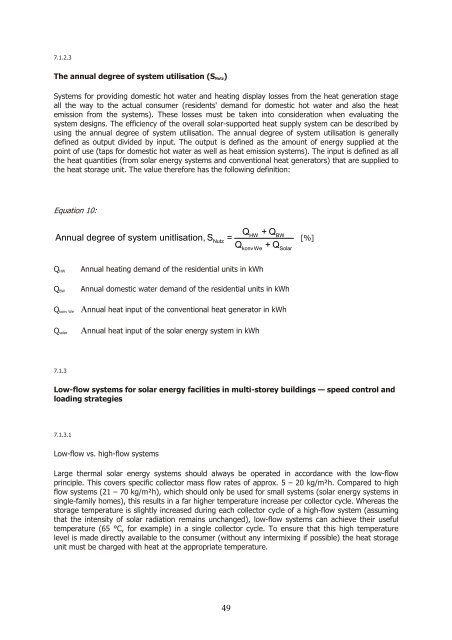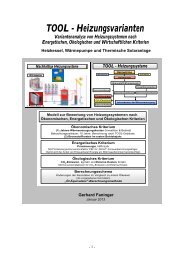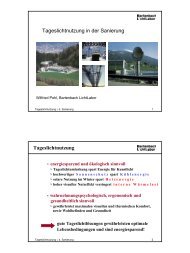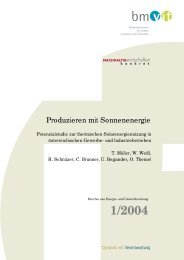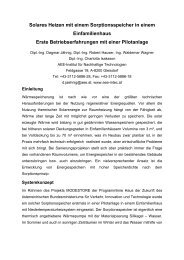Solar-supported heating networks in multi-storey residential buildings
Solar-supported heating networks in multi-storey residential buildings
Solar-supported heating networks in multi-storey residential buildings
Create successful ePaper yourself
Turn your PDF publications into a flip-book with our unique Google optimized e-Paper software.
7.1.2.3<br />
The annual degree of system utilisation (SNutz)<br />
Systems for provid<strong>in</strong>g domestic hot water and <strong>heat<strong>in</strong>g</strong> display losses from the heat generation stage<br />
all the way to the actual consumer (residents' demand for domestic hot water and also the heat<br />
emission from the systems). These losses must be taken <strong>in</strong>to consideration when evaluat<strong>in</strong>g the<br />
system designs. The efficiency of the overall solar-<strong>supported</strong> heat supply system can be described by<br />
us<strong>in</strong>g the annual degree of system utilisation. The annual degree of system utilisation is generally<br />
def<strong>in</strong>ed as output divided by <strong>in</strong>put. The output is def<strong>in</strong>ed as the amount of energy supplied at the<br />
po<strong>in</strong>t of use (taps for domestic hot water as well as heat emission systems). The <strong>in</strong>put is def<strong>in</strong>ed as all<br />
the heat quantities (from solar energy systems and conventional heat generators) that are supplied to<br />
the heat storage unit. The value therefore has the follow<strong>in</strong>g def<strong>in</strong>ition:<br />
Equation 10:<br />
HW BW<br />
Annual degree of system unitlisation, S Nutz =<br />
Q konv We +Q<strong>Solar</strong><br />
QHW<br />
QBW<br />
49<br />
Q +Q<br />
Annual <strong>heat<strong>in</strong>g</strong> demand of the <strong>residential</strong> units <strong>in</strong> kWh<br />
Annual domestic water demand of the <strong>residential</strong> units <strong>in</strong> kWh<br />
Qkonv We Annual heat <strong>in</strong>put of the conventional heat generator <strong>in</strong> kWh<br />
Qsolar<br />
7.1.3<br />
Annual heat <strong>in</strong>put of the solar energy system <strong>in</strong> kWh<br />
Low-flow systems for solar energy facilities <strong>in</strong> <strong>multi</strong>-<strong>storey</strong> build<strong>in</strong>gs — speed control and<br />
load<strong>in</strong>g strategies<br />
7.1.3.1<br />
Low-flow vs. high-flow systems<br />
Large thermal solar energy systems should always be operated <strong>in</strong> accordance with the low-flow<br />
pr<strong>in</strong>ciple. This covers specific collector mass flow rates of approx. 5 – 20 kg/m²h. Compared to high<br />
flow systems (21 – 70 kg/m²h), which should only be used for small systems (solar energy systems <strong>in</strong><br />
s<strong>in</strong>gle-family homes), this results <strong>in</strong> a far higher temperature <strong>in</strong>crease per collector cycle. Whereas the<br />
storage temperature is slightly <strong>in</strong>creased dur<strong>in</strong>g each collector cycle of a high-flow system (assum<strong>in</strong>g<br />
that the <strong>in</strong>tensity of solar radiation rema<strong>in</strong>s unchanged), low-flow systems can achieve their useful<br />
temperature (65 °C, for example) <strong>in</strong> a s<strong>in</strong>gle collector cycle. To ensure that this high temperature<br />
level is made directly available to the consumer (without any <strong>in</strong>termix<strong>in</strong>g if possible) the heat storage<br />
unit must be charged with heat at the appropriate temperature.<br />
[%]


